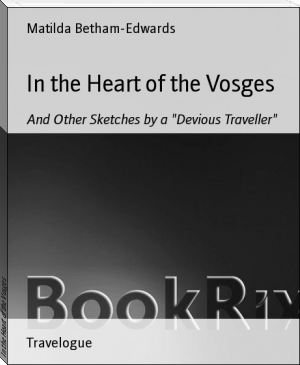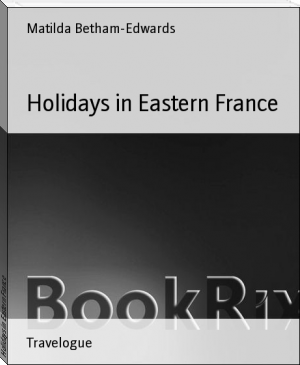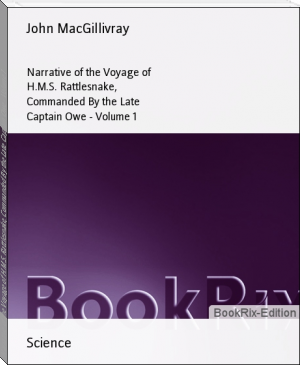In the Heart of the Vosges, Matilda Betham-Edwards [i love reading .txt] 📗

- Author: Matilda Betham-Edwards
Book online «In the Heart of the Vosges, Matilda Betham-Edwards [i love reading .txt] 📗». Author Matilda Betham-Edwards
II
THE CHARM OF ALSACE
The notion of here reprinting my notes of Alsatian travel was suggested by a recent French work--_A travers l'Alsace en flanant_, from the pen of M. Andre Hallays. This delightful writer had already published several volumes dealing with various French provinces, more especially from an archaeological point of view. In his latest and not least fascinating _flanerie_ he gives the experiences of several holiday tours in Germanized France.
My own sojourns, made at intervals among French friends, _annexes_ both of Alsace and Lorraine, were chiefly undertaken in order to realize the condition of the German Emperor's French subjects. But I naturally visited many picturesque sites and historic monuments in both, the forfeited territories being especially rich. Whilst volume after volume of late years have appeared devoted to French travel, holiday tourists innumerable jotting their brief experiences of well-known regions, strangely enough no English writer has followed my own example. No work has here appeared upon Alsace and Lorraine. On the other side of the Channel a vast literature on the subject has sprung up. Novels, travels, reminiscences, pamphlets on political and economic questions, one and all breathing the same spirit, continue to appear in undiminished numbers.
Ardent spirits still fan the flame of revolt. The burning thirst for re-integration remains unquenched. Garbed in crape, the marble figure of Strasburg still holds her place on the Place de la Concorde. The French language, although rigidly prohibited throughout Germanized France, is studied and upheld more sedulously than before Sedan. And after the lapse of forty years a German minister lately averred that French Alsatians were more French than ever. _Les Noellets_ of Rene Bazin, M. Maurice Barres' impassioned series, _Les Bastions de l'Est_, enjoy immense popularity, and within the last few months have appeared two volumes which fully confirm the views of their forerunners--M. Hallays' impressions of many wayfarings and _Apres quarante ans_ by M. Jules Claretie, the versatile, brilliant and much respected administrator-general of the Comedie Francaise.
Whilst in these days of peace and arbitration propaganda the crime of enforced denationalization seems more heinous than ever, there appears little likelihood of the country conquered by Louis XIV., and re-conquered by German arms a century and a half later, again waving the Tricolour.
Let us hope, however, that some _via media_ may be found, and that if not recovering its lost privilege, the passionately coveted French name, as a federal state Alsace and Lorraine may become independent and prosperous.
For a comprehensive study of Alsace and its characteristics, alike social, artistic and intellectual, readers must go to M. Hallays' volume. In every development this writer shows that a special stamp may be found. Neither Teutonic nor Gallic, art and handicrafts reveal indigenous growth, and the same feature may be studied in town and village, in palace, cathedral and cottage.
We must remember that we are here dealing with a region of very ancient civilization. Taste has been slowly developed, artistic culture is of no mushroom growth. Alsace formed the highroad between Italy and Flanders. In M. Hallays' words, already during the Renaissance, aesthetic Alsace blended the lessons of north and south, her genius was a product of good sense, experience and a feeling of proportion. And he points out how in the eighteenth century French taste influenced Alsatian faience, woven stuffs, ironwork, sculpture, wood-carving and furniture, even peasant interiors being thereby modified. "Alsace," he writes, "holds us spell-bound by the originality of culture and temperament found among her inhabitants. It has generally been taken for granted that native genius is here a mere blend of French and German character, that Alsatian sentiment appertains to the latter stock, intellectual development to the former, that the inhabitants think in French and imagine in German. There is a certain leaven of truth in these assumptions, but when we hold continued intercourse with all classes, listen to their speech, familiarize ourselves with their modes of life and mental outlook, we arrive again and again at one conclusion: we say to ourselves, here is an element which is neither Teutonic nor Gallic. I cannot undertake to particularize, I only note in my pages those instances that occur by the way. And the conviction that we are here penetrating a little world hitherto unknown to us, such novelty being revealed in every stroll and chat, lends extraordinary interest to our peregrination."
It is especially an artistic Alsace that M. Hallays reveals to us. Instead of visiting battlefields, he shows us that English travellers may find ample interest of other kind. The artist, the ecclesiologist, the art-loving have here a storehouse of unrevealed treasure. A little-read but weighty writer, Mme. de Stael, has truly averred that the most beautiful lands in the world, if devoid of famous memories and if bearing no impress of great events, cannot be compared in interest to historic regions. Hardly a spot of the annexed provinces but is stamped with indelible and, alas! blood-stained, records. From the tenth century until the peace of Westphalia, these territories belonged to the German empire, being ruled by sovereign dukes and princes. In 1648 portions of both provinces were ceded to France, and a few years later, in times of peace, Strasburg was ruthlessly seized and appropriated by the arch-despot and militarist, Louis XIV. By the treaty of Ryswick, that of Westphalia was ratified, and thenceforward Alsace and Lorraine remained radically and passionately French. In 1871 was witnessed an awful historic retribution, a political crime paralleling its predecessor committed by the French king two centuries before. Alsace-Lorraine still awaits the fulfilment of her destiny. Meantime, as Rachel mourning for her children, she weeps sore and will not be comforted.
Historically speaking, therefore, the annexed provinces present a strangely complex patchwork and oft-repeated palimpsest, civilization after civilization overlapping each other. If Alsace-Lorraine has produced no Titan either in literature or art, she yet shows a goodly roll-call.
The name heading the list stands for France herself. It was a young soldier of Strasburg--not, however, Alsatian born--who, in April, 1792, composed a song that saved France from the fate of Poland and changed the current of civilization. By an irony of destiny the Tricolour no longer waves over the cradle of the Marseillaise!
That witty writer, Edmond About, as well as the "Heavenly Twins" of Alsatian fiction, was born in Lorraine, but all three so thoroughly identified themselves with this province that they must be regarded as her sons. Those travellers who, like myself, have visited Edmond About's woodland retreat in Saverne can understand the bitterness with which he penned his volume--_Alsace 1870-1_--and the concluding lines of the preface--
"If I have here uttered an untrue syllable, I give M. de Bismarck permission to treat my modest dwelling as if it were a villa of Saint Cloud."
The literary brethren whose pictures of Alsatian peasant life, both in war and peace, have become world-wide classics, suffered no less than their brilliant contemporary, and their works written after annexation breathe equal bitterness. The celebrated partnership which began in 1848 and lasted for a quarter of a century, has been thus described by Edmond About: "The two friends see each other very rarely, whether in Paris or in the Vosges. When they do meet, they together elaborate the scheme of a new work. Then Erckmann writes it. Chatrian corrects it--and sometimes puts it in the fire!" One at least of their plays enjoys equal popularity with the novel from which it is drawn. To have witnessed _L'Ami Fritz_ at Moliere's house in the last decade of the nineteenth century was an experience to remember. That consummate artist, Got, was at his very best--if the superlative in such a case is applicable--as the good old Rabbi. No less enchanting was Mlle. Reichenbach, the _doyenne_ of the Comedie Francaise, as Suzel. Of this charming artist Sarcey wrote that, having attained her sixteenth year, there she made the long-stop, never oldening with others. _L'Ami Fritz_ is, in reality, a German bucolic, the scene being laid in Bavaria. But it has long been accepted as a classic, and on the stage it becomes thoroughly French. This delightful story was written in 1864, that is to say, before any war-cloud had arisen over the eastern frontier, and before the evocation of a fiend as terrible, the anti-Jewish crusade culminating in the Dreyfus crime.
It is painful to reflect that whilst twenty years ago the engaging old Jew of this piece was vociferously acclaimed on the first French stage, the drama of a gifted Jewish writer has this year been banned in Paris!
Edmond About and Erckmann and Chatrian belong to the same period as another native, and more famous, genius, the precocious, superabundantly endowed Gustave Dore. Of this "admirable Crichton" I give a sketch.
For mere holiday-makers in search of exhilaration and beauty, Alsace offers attractions innumerable, sites grandiose and idyllic, picturesque ruins, superb forests, old churches of rare interest and many a splendid historic pile.
There are naturally drawbacks to intense lovers of France. Throughout M. Hallays' volume he acknowledges the courtesy of German officials, a fact to which I had borne testimony when first journalizing my own experiences. Certain aspects of enforced Germanization can but afflict all outsiders. There is firstly that obtrusive militarism from which we cannot for a moment escape. Again, a no less false note strikes us in matters aesthetic. Modern German taste in art, architecture and decoration do not harmonize with the ancientness and historic severity of Alsace. The restoration of Hohkoenigsburg and the new quarters of Strasburg are instances in point. All who visited the German art section of the Paris Exhibition in 1900 will understand this dis-harmony.
The reminiscences of my second and third journeys in Alsace and Lorraine having already appeared in volume form, still in print (_East of Paris_), are therefore omitted here. For the benefit of English travellers in the annexed portion of the last-named province I cite a passage from M. Maurice Barres' beautiful story, _Colette Baudoche_. His hero is German and his heroine French, a charming _Messine_ or native of Metz. In company of Colette's mother and a friend or two, the _fiances_ take part in a little festival held at Gorze, a village near the blood-stained fields of Gravelotte and Mars-la-Tour--
"At Gorze, church, lime-trees, dwellings and folks belong to the olden time, that is to say, all are very French.... In crossing the square the five holiday-makers halted before the Hotel de Ville and read with interest a commemorative inscription on the walls. A tablet records English generosity in 1870, when, after the carnage and devastation of successive battles,





Comments (0)